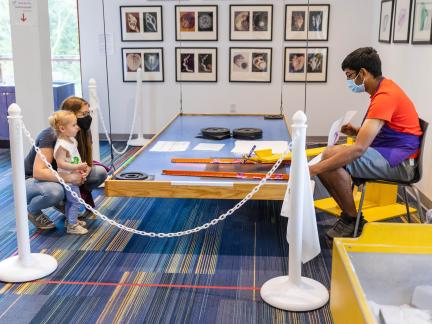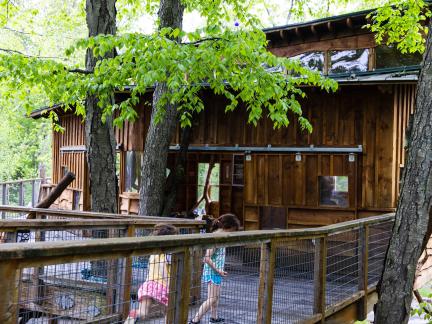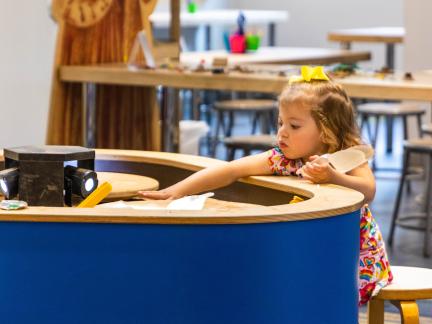A Treehouse Opens at The Discovery Museums
from New England Museums Now: Spring 2017
By Shana Dumont Garr, Curator, Fruitlands Museum
A vaulted, wooden structure seems to hover above a clearing in the woods on the grounds of the Discovery Museums in Acton, Massachusetts. This open-air, ramped building is the Discovery Woods, an inclusive treehouse with adjoining outdoor play areas and a solution to the organization’s longtime mission to get people outside.
I visited the Discovery Woods shortly after it opened in July 2016 with my son, who had just turned three. It had an amiable, eclectic decorative scheme, with diamond-shaped windows located at multiple heights, and little binoculars hanging near, inviting visitors to check out the vista below: a cluster of tents, pathways over a bridge, a swing, and the forest beyond. Within a minute of entering the treehouse, unprompted, my son chose a book from a shelf hung within his reach, plopped onto a bean bag, and began to turn the pages, perusing images of the bugs of New England.
During my visit, the Treehouse engaged multiple senses to provide a sense of adventure and approachability in equal measure. The fragrance of cut wood rose up from passing breezes, and voices of other visitors could be heard from where they were outside. On small tables, empty frames awaited being filled by changeable collages of shells, pine cones, and other organic matter. The effect cumulated to create an atmosphere of having been invited to a retreat forged with the curiosity and inclinations of an individual, providing a glimpse into an obsession with nature that in a way that offers open-ended possibilities of universal connection.
Accessibility and whimsy were both high priorities in this initiative. The appearance and philosophy of the Discovery Woods is in keeping with the displays within their two existing buildings, the Children’s Museum and the Science Museum. The unique and human-scale appearance contains an insightful message that children (and teachers, and parents) can figure things out.
The answers are (and should be) open-ended. Familiar materials such as sand, ping pong balls and hair dryers share complex, hands-on lessons so that visitors can readily, affordably continue their explorations about pendulums, gravity, nanotechnology and more at home.
Two subtle corners of the Science Museum were designed by founder Donald B. Verger’s children in 1985. One is a sky hatch on the third floor, accessed with a simple ladder, at the top allowing views through the ceiling to the sky above. The other is a nook where the wall is made of Plexiglas in place of sheetrock, allowing glimpses of the inner structure of the building. They are both touchingly straightforward in what they offer, but open endless possibilities about what could be discovered by each person who engages with them.
The creative and innovative delivery of information is, after all, what museums are all about, and the Discovery Museums staff approach it in an approachable and inspiring way. “Did you bring your science tools?” they may ask youth just after they disembark from the bus, or “You just designed an experiment,” as students work with new materials in one of the classroom spaces. All of the displays, both indoors and outdoors, seem to come from a very specific mind, a distinctive style providing implicit cues welcoming diverse ideas and methods. I was inspired to visit with key staff and learn more about how this treehouse came to be.
“Yes, the caterpillars are in the treehouse,” Denise LeBlanc, the museum’s Director of Learning Experiences, affirmed in a professional cadence before hanging up the phone. Sam Jaffe, a noted New England based naturalist, was visiting with his Caterpillar Lab, one of numerous partnerships the museum integrates with its ongoing displays.
For instance, the Discovery Museums enlisted the visual artist Kim Bernard (through a NEFA grant), who was also an artist-in-residence at Harvard University’s Physics Department 2016. During one of her programs, Bernard demonstrated pendulum motion in the Science Museum by suspending herself from the ceiling and allowing the students to push her off and observe her movements.
Additional museum partners include the Blue Hills Reservation in Milton, Olin College in Needham, and the Boston Society of Architecture. Twice a year, they train scientists how break down concepts in order to be part of their “Meet the Scientist” program, which complements their vigorous schedule of classroom visits at schools. In every way, from programming to building architecture, the Museums look outward from their walls: and now they have visible connections from their buildings to the conservation land next door, as well.
“Play matters,” said Ann Sgarzi, Director of Marketing. Open-ended time spent exploring and self-motivated play can be seen as currencies in the marketplace. The Creativity Index, a measure of economic potential in a given region, is down throughout the United States. Many parents may find that they have forgotten how to play outside, and the open-scale fixtures enable them to reminisce while climbing, shoveling, and jumping along with the kids they brought. Adults can fit alongside their children in the sandbox or the log huts, and can even walk on the tin cans with strings.
The displays in the Discovery Woods, like those inside, are participatory and invite multiple outcomes. Each space immerses visitors into a theme, and the emphasis is on process, not whether one knows the answers. Sgarzi and LeBlanc explained that many programs in the past five years have made more of an effort to go outdoors. Fairyborough is a trail adjacent to the Discovery Woods that evolved from a weekly program for toddlers and their parents that took place outside each Friday morning. A sign welcoming the fairies stands as a whimsical trailhead, ushering in the possibility of tiny, woodlands creatures. Adjacent to the Museum property is public preservation woodlands, The Great Hill Recreation area, free to museum visitors, who may venture toward its trails.
Fairyborough exemplifies the museum’s receptivity to the visitor experience. People resonate with opportunities to connect to natural structures and find quiet places to retreat. The Treehouse and Fairyborough evolved from their popularity and the organization’s philosophy of the value of moving beyond the walls, both to bring people outdoors and to prompt connections to everyday life outside of a contained museum experience.
When designing the Discovery Woods, the museum partnered with the Treehouse Guys, B’fer Roth and Chris Haake, and also referred to numerous surveys designed with a consulting company, whose expertise helped tease out unexpected desires from caretakers for their children to experience, such as rolling over a rotting log to see the beetles crawling around and engaging in physical activity for fitness and to blow off steam if they were going to be outside.
Having the displays at human scale may appear less grand than the exhibitions at major venues such as the Museum of Science, but their very specificity and relatable size and parts provide lasting, rich experiences.
Some museums celebrate the accomplishments of others, but The Discovery Museums imply that one may be a part of the action, and making it truly engaging includes the implied assurance multiple viewpoints may coexist.
A lovely outcome of working with the Treehouse Guys was a careful inclusion of universal design, something of particular interest to B’fer Roth. Universal design benefits everyone, going beyond accessibility to make it inclusive to those with situational disabilities such as strollers or crutches as well as those with long-term disabilities. The way it works is that every child uses things the same way, rather than having a special slide or ladder just for them. A wonderful example is a swing that is shaped like a low, flat, sturdy disk, that all of the kids vie for, yet it is also safe for a child in a wheelchair to use. This reduces opportunities for visitors to feel that something is not for them.
Advisory boards for families with special needs inform their decisions. Their efforts have been recognized by the Commonwealth Awards, as they are the only Museum winner in the Access category. The physical structure of the Discovery Woods seeks to engage all visitors, and meanwhile the organization continues outreach efforts to expand its audience. Twenty-five percent of their admissions are free. Classrooms visits serve twice as many children as those who visit in person. The museum has further growth on its horizon as well – they are now working with the same architect who designed the Science Museum on plans for an expansion that will remain on their existing property and shift the Children’s Museum to a new structure.
The woods fit with the museum’s mission “to inspire enduring curiosity and love of learning through interactive discovery, hands-on inquiry, and scientific investigation. Their philosophy revolves around the concept of “great play,” the conditions that may bring out a state of fertile curiosity and receptivity in children. Like education reform of the first half of the nineteenth century in Massachusetts, related to Transcendentalist philosophy, they believe that all children are capable of great achievements, and have inner wisdom that may be tapped in as they play. Their philosophy states: “play that is rich, varied, full of experiences, both solitary and with others, with found or repurposed objects, or just with imagination. The cost to provide it is very low. The cost of not having it is very, very high.” The addition of the Discovery Woods, formal outdoor spaces to play and learn, as a central part of the museum’s offerings demonstrates the value of time spent outdoors in nature to stimulate independent learning.
The episode of The Treehouse Guys that included the Discovery Woods was in Season 3 and aired in July 2017 on the DIY network. It was also featured on WCVB-TV Channel 5’s Chronicle in November 2016.Shana Dumont Garr is the Curator of Fruitlands Museum in Harvard, MA, which is a property of The Trustees. She was previously the Director of Kingston Gallery, Boston, and the Director of Programs and Exhibitions at Artspace, NC. She has a MA in Art History from Boston University and a BA in English and Art History from Colby College in Waterville, ME.




